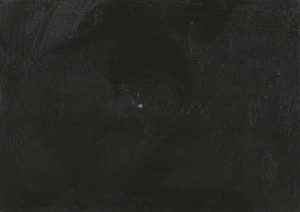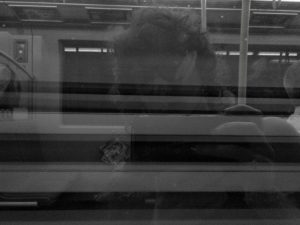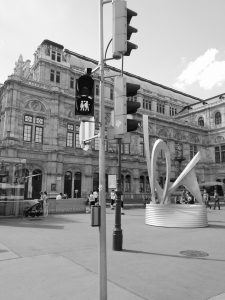by Lexi Lerner
Traveling to a place where no one knows you, nor where anyone’s particularly interested, is terrestrially analogous to Carl Sagan’s Pale Blue Dot. So far away from home, you look over your shoulder at that bright, dense pinprick of everything you’ve ever understood, valued, loved, identified as… and think to yourself: That means nothing out here.

Of course there is the celebrated, luxurious trope of “finding yourself” through travel. But after staring for a long while at the Pale Blue Dot, a disconcerting tannin lingers: a smallness, an inconsequentiality, that renders you and that dense dot mutually invisible, mutually unintelligible. While everything in the universe gravitationally pulls at each other – Voyager 1 to the Dot, me to you – distance makes that attraction faint to the point of unaccountability, or (the semblance of) estrangement. A homelessness that cannot be shaken once felt, even after some sort of return or reconciliation. It’s not finding, it’s losing – irrecoverably.
If all the contextual factors that justified my personhood, that explained the aggregate of my experiences, carved a river of my self, moving to Vienna caused that river to pool out into senseless water: atomized, oceanic, dilute… it could no longer be called a river, or anything at all, really. No house of language could domesticate this gargantuan puddle.
And perhaps there was no river from the start – just a canal calling itself destined so it could keep flowing when it needed to.
First week field notes:
- In summertime the Viennese expel themselves into the countryside like fry from a seahorse. The city is left flabby, its stretch marks the too-wide streets and the too-wide sidewalks. In fact, two sidewalks often run parallel to each other on the same side of the road, accompanied by a stately line of maples, plus an extra bike lane or two, then six lanes of traffic, and the same pedestrian palace road mirrored on the other side. Anticipating throngs that never come.
- There is a preoccupation with modern interior design: mod shapes in natural fibers like wool and wood and cotton and bamboo, the furniture interesting as art pieces but wholly unwelcoming to engage with. In every living room hangs the same Ikea light fixture that looks like a dandelion made of spikes. The chairs purse their lips as you sit. Most don’t have arms.
- Vienna has shoe culture (no trekking dirt into any room past the foyer.) Yet the Viennese don’t walk quietly. Boots clomp on hardwood, on cobblestone. But the architecture is so gaping that it leaves enormous space for silence. That silence fills space.
- The same wind roars through the Augarten tree corridors and the Untergrundbahn tunnels. It’s a kind of wind that sneaks up on you, where you only hear it and see it as you feel it.
“From one part to the other, the city seems to continue, in perspective, multiplying its repertory of images: but instead it has no thickness, it consists only of a face and an obverse, like a sheet of paper, with a figure on either side, which can neither be separated nor look at each other.” (Italo Calvino, Invisible Cities, trans. William Weaver, 1974, p. 105)
 Lately I’ve noticed that subway windows are more telling mirrors than true mirrors are. Come with me. You’re sitting on a train and it makes a booting-up spaceship sound, and the station starts accelerating, slipping away from you, a film reeling by, and suddenly the world outside turns pitch black… backlit by fluorescent lighting, the kind that makes you look as old as you feel, you see yourself dimly in the window reflection, as well as everyone behind you… and this is where I’ve noticed people doing the best analyses of themselves, their true selves (not with their focus lodged between their two front teeth or stuck in a zit or crouched in a cowlick), looking in that dim light at an intimate merging of private and public, both avoiding the eyes of the passengers next to them yet unabashedly meeting their glances when reflected, curiosity and awe and pensive content… and then the outside world bursts into light and the tunnel runs away from you, the window reflection so dim that the passengers behind you disappear and instead the people standing on the platform of this new station come into focus… almost imperceptibly, your own image is superimposed onto the scene outside, more accurate than a mirror since you see yourself in the context of your total surroundings, behind you as reflection and in front of you as transparency, colliding, merging, superimposing, competing, coming in and out of focus depending on the shifting light… the closest you will ever come to being a third person observer of yourself, your own god… the city reels by as you stay constant, measuring yourself up, you versus the not-you.
Lately I’ve noticed that subway windows are more telling mirrors than true mirrors are. Come with me. You’re sitting on a train and it makes a booting-up spaceship sound, and the station starts accelerating, slipping away from you, a film reeling by, and suddenly the world outside turns pitch black… backlit by fluorescent lighting, the kind that makes you look as old as you feel, you see yourself dimly in the window reflection, as well as everyone behind you… and this is where I’ve noticed people doing the best analyses of themselves, their true selves (not with their focus lodged between their two front teeth or stuck in a zit or crouched in a cowlick), looking in that dim light at an intimate merging of private and public, both avoiding the eyes of the passengers next to them yet unabashedly meeting their glances when reflected, curiosity and awe and pensive content… and then the outside world bursts into light and the tunnel runs away from you, the window reflection so dim that the passengers behind you disappear and instead the people standing on the platform of this new station come into focus… almost imperceptibly, your own image is superimposed onto the scene outside, more accurate than a mirror since you see yourself in the context of your total surroundings, behind you as reflection and in front of you as transparency, colliding, merging, superimposing, competing, coming in and out of focus depending on the shifting light… the closest you will ever come to being a third person observer of yourself, your own god… the city reels by as you stay constant, measuring yourself up, you versus the not-you.
“At times the mirror increases a thing’s value, at times denies it… [N]othing that exists or happens… is symmetrical: every face and gesture is answered, from the mirror, by a face and gesture inverted, point by point.” (Calvino, 54)
A 30-something-year-old passenger with heavier bags under her eyes than in her hands sits in the train booth across from mine. A single red rose peeks out of her bag, but the tone of her face isn’t elated enough to justify it. Who was the giver? Where was the rose clipped? Where will she put it? Will she hang it from the rafters, press it in a book, trash it, let it crumble? I wait for the scenery to go dark to watch her reflection in the mirror window. Through some fateful trigonometry, we lock eyes. Her knuckles tighten and blanch, the stem transformed into a hilt.
“[S]taring at me as if demanding recognition, as if to recognize me, as if they had already recognized me.” (Calvino, 95)
Slowly I’ve dared myself to dare people wherever I go. Hold their eyes until they hold mine back. Catch them staring and don’t relent, forcing us into the same plane. Naschmarkt. Prater. Votivkirche. It’s dangerous, desirous, teetering work, cupping your hands around eyes in case stories are blinked out of tear ducts.
“I turned my gaze aside; I no longer dared look anyone in the face. I thought: ‘If Adelma is a city I am seeing in a dream… the dream frightens me. If Adelma is a real city… the resemblances will dissolve, alien faces will appear, bearing anguish. In either case it is best for me not to insist on staring at them.’” (Calvino, 94)
Second week field notes:
- Is the alien hypo- or hypervisible? Perhaps the most serious blunder the tourist makes is thinking they’re invisible, since it renders them all the less so. “I feel anonymous,” a Danish traveler admitted when I caught him staring awkwardly at a spot on the wall just over my right ear. But as I perambulate silently in unmarked clothes knowing no one in my neighborhood, I know that if I disappeared, there wouldn’t even be a hole in the air where I was snatched.
- On a dark street at three in the morning, a group of men catcalled me, almost blocking my path, almost threatening to follow. But it was in Deutsch so I had no understanding and thus no response. What was I supposed to do – pause and say, Sorry, could you repeat that in English? Only the question mark followed me to the apartment; but it was pervasive, buzzing like their confused muttering, which I vigorously splashed away with cold water on my face.
Vienna phases in and out of linguistic understanding. I latch onto everything from gesticulations to cognates to the occasional sign in bona fide English, the latter of which is dedicated to reel in tourists and expats like me – See, there is a place for you here, there is a place for English everywhere. Despite the hegemony of the English language and American culture (songs in taxis, stores, and music festivals are all in English and hail from stateside studios), the individual nonbelonger ghosts through daily life, melting into alley walls and market aisles, as conversations that could have – should have? – happened, cannot.
And there are so many levels of mediation – of media separating one expression, one utterance of the soul from another, slowing it, distorting it. The Google Translate app is distortion; your agape mouth and hands pulling words from the air are distortion; the traumas heavier than our checked bags, that you can’t believe made it all this way, that make denotation ooze connotation, are distortion.
“There is no language without deceit.” (Calvino, 48)
Perhaps a universal language would be one without medium. Beyond the corporeal, perhaps even beyond the sensate. Some of the dead feel more real than the shimmering, untouchable living.
“All the rest of the city is invisible… Your footsteps follow not what is outside the eyes, but what is within, buried, erased.” (Calvino, 90-91)
A few years ago Christopher Wool’s work was at the Guggenheim and I spent a long time with one particular painting. It was as large as a closet and had black letters stenciled onto a white background. THE HARDER YOU LOOK THE HARDER YOU LOOK. But if you looked very closely at the second half of the sentence, it’s evident this was a revision, that there was a different message underneath: THE HARDER YOU LOOK THE HARDER IT LOOKS BACK.
“Signs form a language, but not the one you think you know.” (Calvino, 48)
 Around the Wiener Staatsoper I noticed that the little green person on the pedestrian traffic lights had been pluralized into two little green people. When Austria hosted Eurovision three years ago, these lights were installed as a queer-friendly initiative. Some of the figures wear dresses, some not. In case holding hands was not clear enough, a tiny LED heart hovers between their heads.
Around the Wiener Staatsoper I noticed that the little green person on the pedestrian traffic lights had been pluralized into two little green people. When Austria hosted Eurovision three years ago, these lights were installed as a queer-friendly initiative. Some of the figures wear dresses, some not. In case holding hands was not clear enough, a tiny LED heart hovers between their heads.
Halfway through the crossing my hand felt cold; by habit, it reached into my back pocket for the phone to text my own little green person. They live six thousand kilometers and many opportunities away. But supposedly LEDs have exceptional battery life. If we had a tiny diodic heart, it would be hovering somewhere along the North Atlantic, battered and salt-sprayed but still luminous.
Could I love you? I thought as I gazed at the Donaukanal’s graffitied underpass. The dynamic movement of the water against the backdrop of Jugendstil and Baroque, different histories coexisting through competition – the iconic, the excessive, the colorful, the established, the anachronism of old and new, the land and its undercurrent, eroding and fertilizing…
“If, of two arcades, one continues to seem more joyous, it is because thirty years ago a girl went by there, with broad, embroidered sleeves…” (Calvino, 90-91)
I recently encountered a social experiment conducted by the comedian Nathan Fielder. He sat a pink-haired stranger across from him and asked her to look him in the eyes and say, “I love you.” She did. Again, he prompted. I love you, she answered. Pause.
Again. I love you. Again. I love you. Again. I love you. Again. I love you. Again. You have tears in your eyes…
“[T]here runs an invisible thread that binds one living being to another for a moment, then unravels, then is stretched again between moving points as it draws new and rapid patterns so that at every second the unhappy city contains a happy city unaware of its own existence.” (Calvino, 149)
Everywhere I search for her, the girl with broad, embroidered sleeves. In the rainbows that refract off the Votivkirche windows at sunset. In the bottoms of coffee cups and at pale pink roses. But mostly in eyes: the Polish boy searching for supermarket seltzer, the Roma man selling four priceless violins, the Slovenian girl cradling her cat as a makeshift pulpous heart. The spray-painted frowning face I found in an alley, captioned: Meine Tränen sind dein.
“[E]ach of their actions is, at once, that action and its mirror-image, which possesses the special dignity of images, and this awareness prevents them from succumbing for a single moment to chance and forgetfulness.” (Calvino, 53)
“When you toast, you need to look into the other person’s eyes,” he told me as the shot burned my throat. I wasn’t sure what I was drinking, and I wasn’t sure why I was drinking it – a vial of clear liquid with a viscosity between soap and water.
“Why?”
“It’s just what we do. You’ll be forgiven because you’re foreign, but still.” He ashed his cigarette. He was Austrian but his parents were not.
“Was there anything else I’m missing?”
“No. Just that.”
“Our planet is a lonely speck in the great enveloping cosmic dark. In our obscurity, in all this vastness, there is no hint that help will come from elsewhere to save us from ourselves.” (Carl Sagan, Pale Blue Dot, 1994)
No hint other than the way his eyes met mine in delayed toast. The kind of forgiveness that comes from having once been forgiven.
I didn’t drink any more that night or since. But I’ve been practicing even when served water: you look into my eyes, I look into yours, the glasses clink at our singular moment in time and space. Even Voyager 1 stared six billion kilometers into darkness to celebrate with the tiny Pale Blue Dot – that strangely fertile point of everything we’ve ever understood, valued, loved, identified as… – the glory of being so far away yet nearly touching.
After three weeks it has begun. The rain last night sounded like rain. The seaboard recycled into urban shower, downpouring the foreign and indigenous, crying, relieving, each molecule sourced from a different river, conglomerating into distinct drops and releasing into utter wetness as I sprinted for shelter, under awning, clouds, stars.
(And from far, far away… the gentlest tug…)
